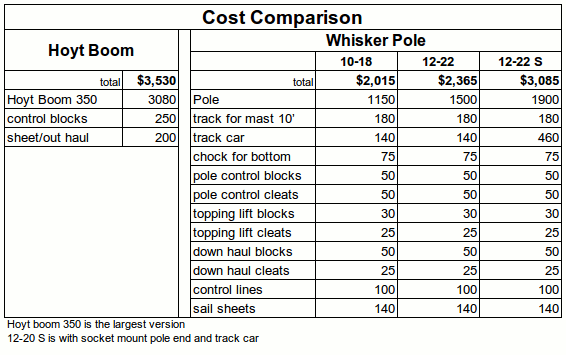

| Hoyt Jib Boom / Whisker Pole Comparison |
Hoyt Jib Boom Overview
Installation Details
Hoyt Jib Boom by Forespar
The Forespar Hoyt Jib Boom is an expensive piece of gear. About $3,000 for the size needed for my boat. This is actually in line with the price of a new sail. What is the cost compared to a good whisker pole setup and how do they compare for performance and ease of use? For comparison I'll consider a good whisker pole system one that has a line controlled pole mounted to a track on the mast for the easiest deployment. For the 10M that would take either a Forespar 10-18 pole or a 12-20. Prices vary depending on options. I'll look at aluminum poles, carbon fiber would more than double the cost.

So the basic comparison that includes all the component costs is about $3,500 for the Hoyt Boom, and $2,000 to $3,000 for a Forespar line control mast mounted pole depending on options. Installation would probably cost a bit more for the Hoyt boom becasue of the under-deck backing plate needed. Or you could just have the pole for about $1,200 but you still need a way to stow it, and some control lines so maybe $1,400 that way?
Ease of Use
To use the pole requres leaving the cockpit to deploy the pole and then adjustment of the various control lines. The Hoyt Jib Boom is always in place and deployed and has only two control lines. It's also a lot easier to tack and gybe the boat withthe Hoyt boom.
| Whisker Pole | Hoyt Boom |
|
Whisker Pole Control Lines 1) Port genoa sheet 2) Stbd genoa sheet 3) Pole lift 4) Downhaul 5) Control line to extend the pole 6) Mast car control line |
Hoyt boom control lines 1) Outhaul 2) Sheet (single) |
|
Steps to tack without the Hoyt boom 1) Turn the boat through the wind 2) Release the working sheet 3) Take in the lazy sheet 4) Grind to trim with winch |
Steps to tack with the Hoyt boom 1) Turn the boat through the wind
You don't need to trim after the tack |
|
Steps for a gybe with the end-for-end pole 1) Release pole 2) Shift pole to other side end-for-end 3) Re-connect pole at mast 4) Gybe the boat 5) Release sheet 6) Take up on other sheet 7) Re-connect pole at sail 8) Trim sail |
Steps to gybe the Hoyt boom 1) Gybe the boat
You don't need to trim after the gybe |
|
Steps for a gybe with the dip type pole 1) Release pole from sail 2) Release mast car line and raise on mast 3) Swing pole to other side 4) Gybe the boat 5) Release sheet 6) Take up on other sheet 7) Re-deploy pole and secure 8) Trim sail
|
Steps to gybe the Hoyt boom 1) Gybe the boat
You don't need to trim after the gybe |
Performance
Performance can have different aspects. To a racer it's about VMG. To a cruiser VMG might be less important than ease of use issues outlined above. The Hoyt boom is always there, deployed and doing what it was designed for to control sail shape for best performance of the jib. But if we look at VMG there are a few different things to check. Upwind on a close-hauled course you don't need the pole. An overlapping genoa should have a bit more boat speed up to the wind speed where you're changing down to a jib. The non-overlapping Hoyt boom might sheet a bit closer than the genoa for better pointing and it will tack faster. In less than 8-10 knots the genoa might be faster unless you get into a tacking duel.
As you fall off the genoa will have more power until you get to the point where you cant sheet further outboard. Then you start loosing the top of the sail to twist. The Hoyt boom will keep that under control and at some point you'll have more drive with the jib on the boom than the genoa without. This is where the pole comes in. You can set the pole and control the clew to get the proper shape back. I would expect the genoa on the whisker pole to be faster than the jib on the Hoyt boom on the same point of sail until you get to the wind level where the genoa becomes over-powered. It will be more to rig and trim but it should be faster up to the wind speed where you are down to the same size jib.